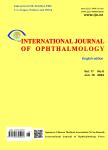Temporal retinal thinning might be an early diagnostic indicator in male pediatric X-linked Alport syndrome
作者机构:Department of OphthalmologyPeking University First HospitalBeijing 100034China Department of PediatricsPeking University First HospitalBeijing 100034China
出 版 物:《International Journal of Ophthalmology(English edition)》 (国际眼科杂志(英文版))
年 卷 期:2022年第15卷第7期
页 面:1142-1148页
核心收录:
学科分类:1002[医学-临床医学] 100210[医学-外科学(含:普外、骨外、泌尿外、胸心外、神外、整形、烧伤、野战外)] 100212[医学-眼科学] 10[医学]
主 题:Alport syndrome retinal thickness spectral domain optical coherence tomography segmentation
摘 要:AIM: To evaluate temporal retinal thinning changes in retinal layers using spectral-domain optical coherence tomography(SD-OCT) in pediatric X-linked Alport syndrome(XLAS) ***: A retrospective case-control study. SDOCT scans of pediatric patients diagnosed with XLAS and age-and sex-matched healthy control participants were reviewed. Automated segmentation of SD-OCT scans was induced to analyze the retinal thickness(RT) of different layers. The temporal thinning index(TTI) was calculated for each layer and compared between the patients and the control ***: Forty-three pediatric XLAS patients and 60 healthy controls were included. Temporal retinal thinning was present in 33 patients(76.74%), while 28 patients(65.11%) had severe pathological temporal retinal thinning and 5 patients(11.63%) had moderate thinning. The temporal inner sector RT(P0.0001), the temporal outer sector RT(P0.0001), and the nasal outer sector RT(P=0.0211) were significantly thinner in the XLAS male patients. The TTI of the total retina was significantly higher in the XLAS group than in the control group(P0.0001). The TTI of the inner retina layers(P0.0001), ganglion cell layer(P0.0001), inner plexiform layer(P0.0001), inner nuclear layer(P0.0001), and outer nuclear layer(P0.0001) were significantly higher in the XLAS group. The central RT of the XLAS group was significantly thinner than that of the control group(P0.0001).CONCLUSION: Temporal retinal thinning appears early in XLAS patients, especially in male patients. The thinningis mainly caused by structural abnormalities of the inner retina. This suggests that temporal retinal thinning could be helpful for the early diagnosis and follow-up of XLAS with noninvasive SD-OCT examination.



